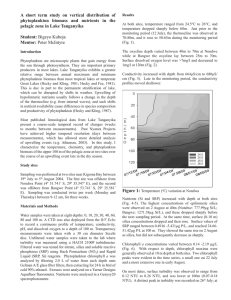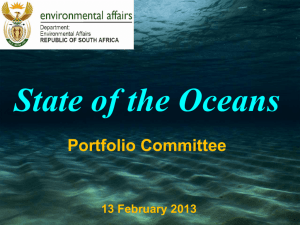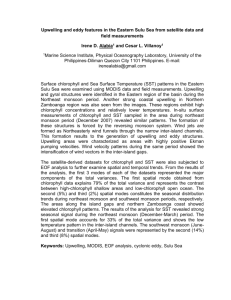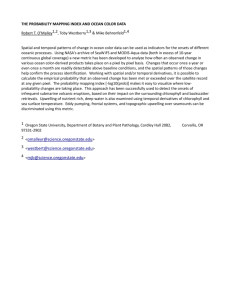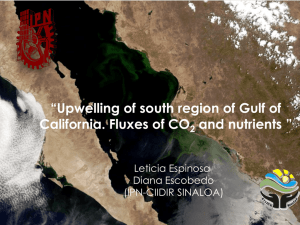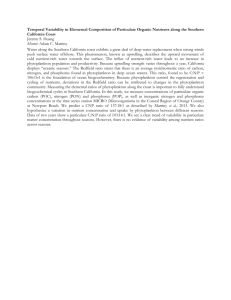A littoral survey in Lake ...
advertisement
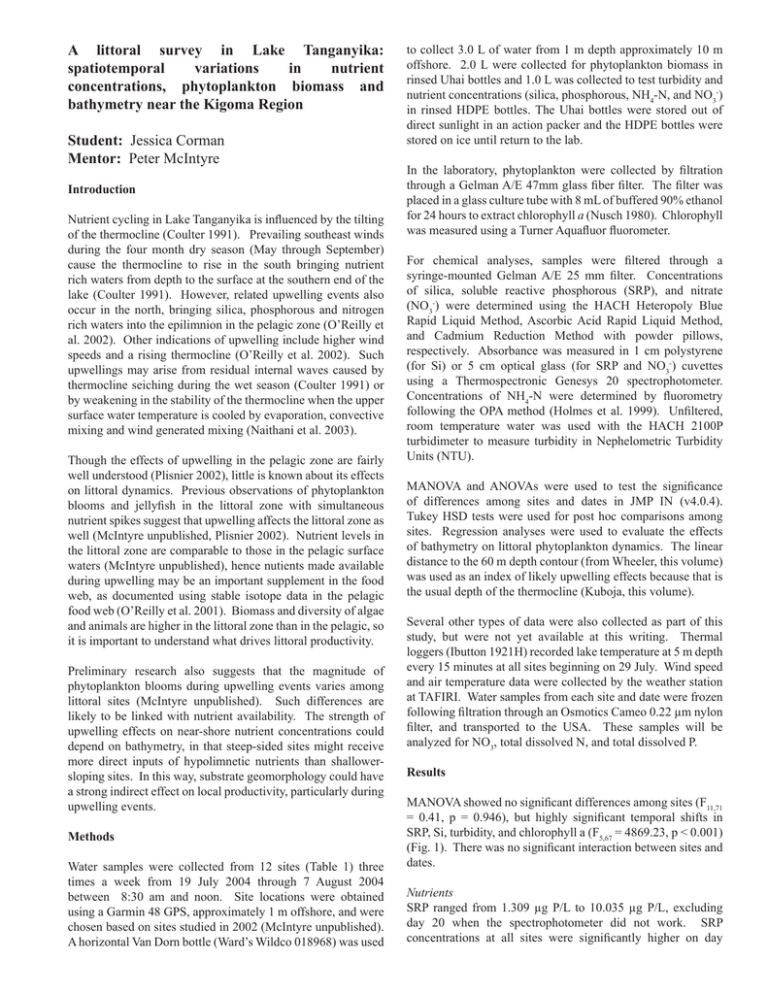
A littoral survey in Lake Tanganyika: spatiotemporal variations in nutrient concentrations, phytoplankton biomass and bathymetry near the Kigoma Region Student: Jessica Corman Mentor: Peter McIntyre Introduction Nutrient cycling in Lake Tanganyika is influenced by the tilting of the thermocline (Coulter 1991). Prevailing southeast winds during the four month dry season (May through September) cause the thermocline to rise in the south bringing nutrient rich waters from depth to the surface at the southern end of the lake (Coulter 1991). However, related upwelling events also occur in the north, bringing silica, phosphorous and nitrogen rich waters into the epilimnion in the pelagic zone (O’Reilly et al. 2002). Other indications of upwelling include higher wind speeds and a rising thermocline (O’Reilly et al. 2002). Such upwellings may arise from residual internal waves caused by thermocline seiching during the wet season (Coulter 1991) or by weakening in the stability of the thermocline when the upper surface water temperature is cooled by evaporation, convective mixing and wind generated mixing (Naithani et al. 2003). Though the effects of upwelling in the pelagic zone are fairly well understood (Plisnier 2002), little is known about its effects on littoral dynamics. Previous observations of phytoplankton blooms and jellyfish in the littoral zone with simultaneous nutrient spikes suggest that upwelling affects the littoral zone as well (McIntyre unpublished, Plisnier 2002). Nutrient levels in the littoral zone are comparable to those in the pelagic surface waters (McIntyre unpublished), hence nutients made available during upwelling may be an important supplement in the food web, as documented using stable isotope data in the pelagic food web (O’Reilly et al. 2001). Biomass and diversity of algae and animals are higher in the littoral zone than in the pelagic, so it is important to understand what drives littoral productivity. Preliminary research also suggests that the magnitude of phytoplankton blooms during upwelling events varies among littoral sites (McIntyre unpublished). Such differences are likely to be linked with nutrient availability. The strength of upwelling effects on near-shore nutrient concentrations could depend on bathymetry, in that steep-sided sites might receive more direct inputs of hypolimnetic nutrients than shallowersloping sites. In this way, substrate geomorphology could have a strong indirect effect on local productivity, particularly during upwelling events. Methods Water samples were collected from 12 sites (Table 1) three times a week from 19 July 2004 through 7 August 2004 between 8:30 am and noon. Site locations were obtained using a Garmin 48 GPS, approximately 1 m offshore, and were chosen based on sites studied in 2002 (McIntyre unpublished). A horizontal Van Dorn bottle (Ward’s Wildco 018968) was used to collect 3.0 L of water from 1 m depth approximately 10 m offshore. 2.0 L were collected for phytoplankton biomass in rinsed Uhai bottles and 1.0 L was collected to test turbidity and nutrient concentrations (silica, phosphorous, NH4-N, and NO3-) in rinsed HDPE bottles. The Uhai bottles were stored out of direct sunlight in an action packer and the HDPE bottles were stored on ice until return to the lab. In the laboratory, phytoplankton were collected by filtration through a Gelman A/E 47mm glass fiber filter. The filter was placed in a glass culture tube with 8 mL of buffered 90% ethanol for 24 hours to extract chlorophyll a (Nusch 1980). Chlorophyll was measured using a Turner Aquafluor fluorometer. For chemical analyses, samples were filtered through a syringe-mounted Gelman A/E 25 mm filter. Concentrations of silica, soluble reactive phosphorous (SRP), and nitrate (NO3-) were determined using the HACH Heteropoly Blue Rapid Liquid Method, Ascorbic Acid Rapid Liquid Method, and Cadmium Reduction Method with powder pillows, respectively. Absorbance was measured in 1 cm polystyrene (for Si) or 5 cm optical glass (for SRP and NO3-) cuvettes using a Thermospectronic Genesys 20 spectrophotometer. Concentrations of NH4-N were determined by fluorometry following the OPA method (Holmes et al. 1999). Unfiltered, room temperature water was used with the HACH 2100P turbidimeter to measure turbidity in Nephelometric Turbidity Units (NTU). MANOVA and ANOVAs were used to test the significance of differences among sites and dates in JMP IN (v4.0.4). Tukey HSD tests were used for post hoc comparisons among sites. Regression analyses were used to evaluate the effects of bathymetry on littoral phytoplankton dynamics. The linear distance to the 60 m depth contour (from Wheeler, this volume) was used as an index of likely upwelling effects because that is the usual depth of the thermocline (Kuboja, this volume). Several other types of data were also collected as part of this study, but were not yet available at this writing. Thermal loggers (Ibutton 1921H) recorded lake temperature at 5 m depth every 15 minutes at all sites beginning on 29 July. Wind speed and air temperature data were collected by the weather station at TAFIRI. Water samples from each site and date were frozen following filtration through an Osmotics Cameo 0.22 µm nylon filter, and transported to the USA. These samples will be analyzed for NO3, total dissolved N, and total dissolved P. Results MANOVA showed no significant differences among sites (F11,71 = 0.41, p = 0.946), but highly significant temporal shifts in SRP, Si, turbidity, and chlorophyll a (F5,67 = 4869.23, p < 0.001) (Fig. 1). There was no significant interaction between sites and dates. Nutrients SRP ranged from 1.309 µg P/L to 10.035 µg P/L, excluding day 20 when the spectrophotometer did not work. SRP concentrations at all sites were significantly higher on day Discussion Despite complications in quantifying NO3- and NH4-N, it is apparent that the concentrations of these nutrients, as well as silica and phosphorous were very low during baseline conditions in the littoral zone. As in previous years, there were no strong differences among littoral sites in water chemistry, but strong and spatially-coherent patterns through time. The lack of significant spatiotemporal interactions indicates that nutrients and chlorophyll a shift concordantly through time at each site. Figure 1: The average concentrations (with error bars representing the standard deviation) of soluble reactive phosphorous, chlorophyll a, and silica during the sampling period 18 than any other day (p < 0.0001). Silica ranged from 616 µg Si/L to 1028 µg Si/L. The level of silica also differed significantly by day; day 18 was higher than days 1, 4, 6, 8, and 15, and day 20 was higher than days 4 and 8 (p < 0.0001). The levels of NO3- were always below the detection level of the spectrophotometer, 50 µg N/L, thus are not included in this analysis. The concentration of NH4-N was always below 2.25 µg N/L and often below the level of the zero standard, thus the data are not included in this analysis. Chlorophyll a Concentrations of chlorophyll a, a proxy for phytoplankton biomass, ranged from 0.514 µg/L to 4.391 µg/L. There were significant differences among both sites and days (p = 0.037 and p < 0.0001, respectively). Chlorophyll a was significantly higher on day 20 than any other date. Turbidity Turbidity ranged from 0.11 NTU to 1.90 NTU. Turbidity was significantly higher on day 8 than all other days (p < 0.001) (Fig. 2). On day 8, unusual waves out of the north were at least 2 m high and the water clarity was observed to be very low during sampling. Bathymetry There was no significant correlation between the distance of the 60m contour and the level chlorophyll a, whether during baseline conditions or an upwelling event. There was strong evidence of an upwelling event in the littoral zone on day 18. On that date, concentrations of SRP and silica were relatively high, jellyfish were seen in the littoral zone, water clarity was poor for snorkeling (<5 m), and zooplanktivorous fish had formed unusually large schools. An initial look at the thermologger data supports this interpretation, as does the rising thermocline and chemoclines in the pelagic zone (Kuboja, this volume). To examine the effects of upwelling, I compared the mean values from the six days prior to the upwelling (herafter “baseline”) to the two dates during and post- upwelling (hereafter “upwelling”; Fig. 3). At all sites but site 1, SRP concentrations were higher on day 18 than on any other day. At sites 3, 5, 7, and 9 - 11, the level of SRP increased over 3 µg P/L. The silica concentration also increased on day 18 at all sites but 2 and 8. Silica increased over 50 µg Si/L at sites 4 – 7 and 10 - 12. Within two days, silica had decreased again at all the sites (except site 2), including drops >50 µg Si/L at sites 4 – 5 and 7 - 12. Chlorophyll a concentration did not respond immediately to the increases in nutrients (Figs. 1 and 3). However, a phytoplankton bloom was evident on day 20 all sites except site 1, and the bloom persisted beyond the end of the sampling period. The lag in phytoplankton response to upwelling is not unexpected, as consumer population dynamics usually show a time-delay in following the dynamics of limiting resources. Analysis of the baseline nutrient and chlorophyll data indicate that phytoplankton biomass is best predicted by SRP (p < 0.008), as has been observed in previous years (McIntyre unpublished). There was also clear experimental evidence of P-limitation of benthic algae in 2004 (Thoms, this volume). The reason for the lack of response of phytoplankton at site 1 to upwelling remains to be determined. That site is protected from the north but probably receives high winds from the south, and either could affect mixing and upwelling dynamics. The magnitude of the changes in nutrients and phytoplankton were not significantly related to bathymetry. However, bathymetry remains the most likely explanation for spatial differences in the strength of upwelling effects. I hope that the thermal data will help to resolve whether there were differences in the hydrodynamic signature of upwelling across sites. Figure 2: The average turbidity at all sites on each day Interestingly, chlorophyll a was not significantly related to turbidity. Because Lake Tanganyika is usually very clear, changes in turbidity are generally slight and events such as Figure 3: The concentration of soluble reactive phosphorous, silica and chlorophyll a at each site during baseline conditions (from Day 1 until Day 18), upwelling conditions (Day 18) and post-upwelling conditions (Day 20). increased wave action could give a significant rise in turbidity values that does not correspond to phytoplankton blooms. For instance, the turbidity peak on day 8 was not associated with a peak in chlorophyll a. Alternative causes of turbidity include resuspension of benthic particulates, or a microbial explosion. Conclusions and Recommendations Because the nutrient concentrations in Lake Tanganyika are so low, the methods used to detect the different parameters are inherently subject to noise and thus difficult to compare spatially during baseline conditions. In future years, strides should be made to improve the techniques to detect NH4-N and NO3- so quantitative data may be achieved. This may be especially important with NO3-, as its presence is a direct indication of an upwelling event (O’Reilly et al. 2002). Repeated documentation of of upwelling events in future years will further elucidate the productivity patterns and their causes in the littoral zone. Acknowledgements Many thanks are in order for all those that helped me on this project: Tana Hintz, for helping me so much in the lab and the field; the rest of the Team Limno; all the boat drivers (Pete, George, Britt, Trish and Joe); the entire Nyanza team for keeping me sane (and for trips to the Prison Bar); and especially to my mentor, Pete McIntyre, for his dedication and always amusing off-handed comments. Funding for this work was provided by NSF grant ATM # 0223920. Works Cited Coulter, GW. 1991. Lake Tanganyika and It’s Life. London: Oxford University Press. Holmes, R.M., A. Aminot, R. Kerouel, B.A. Hooker, and B.J. Peterson. 1999. A simple and precise method for measuring ammonium in marine and freshwater ecosystems. Can. J. Fish. Aquat. Sci. 56: 1801-1808. McIntyre, P.K. 2004. Personnal communication. Merriam, L. 2003. Nutrient response to dry season upwelling in the pelagic zone of Lake Tanganyika. 2003 Nyanza Report, 73-77. Naithani, J., E. Deleersnijder and P. Plisnier. 2003. Analysis of Wind-Induced thermocline oscillations of Lake Tanganyika. Environmental Fluid Mechanics 3: 2339. Nusch, E.A. 1980. Comparison of different methods for chlorophyll and phaeopigment determination. Arch. Hydrobiol. 14:14-36. O’Reilly, C.M., R.E. Hecky, A.S. Cohen, and P.-D. Plisnier. 2002. Interpreting stable isotopes in food webs: Recognizing the role of time averaging at different trophic levels. Limnol. Oceanogr. 47(1): 306-309. Plisnier, PD. 2002. Limnological Profiles and their variability in Lake Tanganyika. In: The East African Great Lakes: Limnology, Paleolimnology and Biodiversity. Eds. E.O. Odada and D.O. Olago. Netherlands: Kluwer Academic Publishers: 349-366. Table 1. Site names, locations, and distance from shore to the 60m bathymetric contour. Site ID 1 2 3 4 5 6 7 8 9 10 11 12 Name Mzungu Beach Jakobsen Outer Jakobsen Inner Jakobsen North Bangwe Point/Maji Menge Katabe South Katabe North/Hilltop Cave Hilltop Nondwa Point Euphorbia Kalalangabo South Kalalangabo North Latitude (4o) 55.067’ 54.982’ 54.804’ 54.516’ 54.161’ 54.003’ 53.694’ 53.277’ 51.769’ 50.956’ 50.630’ 50.191’ Longitude (29o) 35.911’ 35.766’ 35.901’ 35.822’ 35.682’ 36.037’ 36.735’ 36.795’ 36.509’ 36.526’ 36.445’ 36.512’ Distance to 60m contour (m) (Wheeler, this volume) 535 201 273 190 195 680 898 655 301 182 172 446


